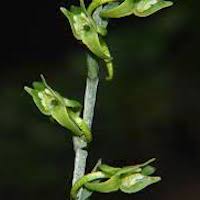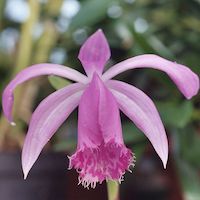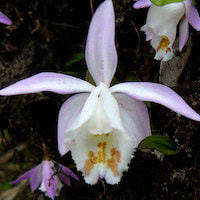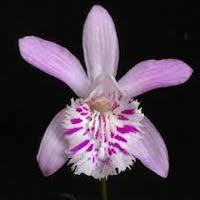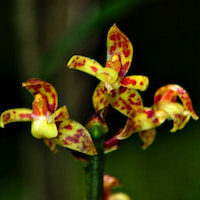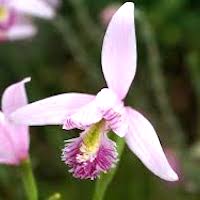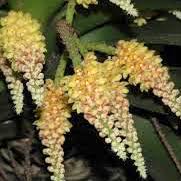|
Macodes petola (Blume) Lindl.
Indonesian names: Daun aksara (calligraphic leaf), Djaksara, Djukut sastra, Ki-aksara, Kidjaksara (Sundanese) Daun patola (Javanese) It is a Southeast Asian Jewel Orchid. It has beautiful, dark green leaves. It is distributed in Malaysia, Singapore and Indonesia. Indonesian legend says that this magical plant first arose from the fragments of a beautiful scarf belonging to a goddess. Herbal Usage: Juice extracted from leaves was recommended to be dropped into the eyes to correct myopia in Indonesia. |
|
Malaxis monophyllos (Linn.) Sw. var. Monophyllos Syn. Liparis japonica (Miq.) Maxim
Chinese name and medicinal name: Yangersuan (sheep ear garlic) Japanese name: Seitakasuzumushiso It occurs as a lithophyte on moss-laden rocks in shady locations in China (Dongbei, Shanxi, Hebei, Shaanxi, Gansu, Sichuan and Guizhou) and Japan. Flowering season is June to August. Herbal Usage: Its medicinal properties include- “stimulating blood circulation, regulating menstruation, haemostasis, relief of pain, strengthening the heart, tranquilising, stopping severe diarrhea, alleviating leucorrhea and relieving postpartum abdominal pain. It is also used as an emergency treatment for external injuries”. It can reduce inflammation, dissolve extravasated blood and cause swellings to subside. The whole plant is used to stop pain and bleeding, especially in cases of trauma, continuous inter-menstrual bleeding and discharge. |
|
Malaxis muscifera (Lindl.) Kuntze.
Ayurvedic names: Jeevak, Jivaka, Chiranjivi, Dirghayu, Harsanga, Ksveda, Kurchasira, Pranda, Risvak, Sringaka, Svadu, (in Gahwal) Rishbhak, Chiranjiva, Dirghayu, Harsanga, Ksveda, Kurchasira, Pranda, Sringaka, Svadu, Banndhura, Dheera, Durdhara, Gopati, Indraksa, Kakuda, Matrika, Vrisha and Vrishnaba. Nepalese name: Jivaka This has one of the most interesting life-cycle. In the western Himalayas, it emerges a few days after snow melts in April. New plants commence their life by germinating from seed or from dormant apical buds on old pseudobulbs. The species is perennial and remains in vegetative phase during the first 2 years of growth. During the third or subsequent year, a flowering rachis emerges, completing flowering and fruiting in the brief summer. With the onset of winter in September, senescence of aerial parts occurs and underground tubers go into dormancy again. Herbal Usage: Jeevak is one important component of eight vitalising herbs (Jivaniya) mentioned in Caraka Samhita, the original Materia Medica of Ayurveda of Mahakashaya. These eight herbs are collectively referred to as Ashtavarga. Rishbhaka is said to be sweet in taste, and cold in potency. It pacifies varta and aggravates kapha and therefore it benefits hyperactive people but is unsuitable for overweight people. It is used to treat general debility and emaciation. In Garhwal, in Himalayas, the tonic is prepared by mixing dried, powdered pseudobulbs in boiled milk. It reduces fever, promotes spermatogenesis, and considered an aphrodisiac. In modern terminology, it is “anti-oxidant and anti-ageing”. In Nepal, paste is made from pseudobulbs to treat pruritus, fever and sores. In CTM, plant is antipyretic and detoxifies. It promotes regular menses and diuresis, It is used to treat sexual dysfunction, weak kidneys, coughs, discharges, menorrhagia and abdominal pain during the post-natal period |
|
Malaxis versicolor (Lindl.) Abeyw. Syn. Microstylis vesicolor Lindl., Seidenfia versicolor Marg. and Szlach.
The color of the plant and flowers are influenced by light intensity: pure green in bright light, deep purple in the shade, and yellowish inbetween. Herbal Usage: In the western part of the Indian peninsula, a potion made with the plant is used to treat fever, biliousness and infantile epilepsy. Also called Jeevak, it is a popular India medicinal herb that is used as a tonic and aphrodisiac in addition to its application for diverse medical conditions like fever, dysentery, rheumatism and even minor complaints like insect bites. It is supposed to boost fertility. This orchid (Jeevak) and Crepidium acuminatum (Rishbaka) are two important constituents of Astavarga, an Indian “rejuvenating” tonic that substitutes as aphrodisiac and semen booster. |
|
Microtis unifolia (Forst.) Rchb. f.Syn. Microtis formosana Schltr. ex Masam
Chinese names: Jiuye Lan (garlic leaf orchid), Congye Lan (onion leaf orchid), Chinese medicinal names: Shuangshencao (two-kidney grass); Zhuitaocao (drop peach grass); Yigencong (single piece onion grass); Chengtuocao (weight grass) Maori name: Maikaika Plants intended for medicinal use are collected from the wild in April and May, washed and dried. Herbal Usage: The whole plant benefits the spleen and kidneys, and removes gas and humidity. It is used to treat weak spleen, anorexia, discharges, weak kidneys, backache and pain from hernia. To prepare a decoction, 30–60 g of the fresh plant or 15–30 g of the dried product is used. In Australia and New Zealand, the plant is eaten by Maori children during periods of stress. |
|
Mycaranthes pannea (Lindl.) S. C. Chen and J. J. Wood Syn.: Eria pannea Lindl.
Chinese name: Zhiyemao Lan (finger leaf hairy orchid), Zhiyenimaolan Chinese medicinal name: Shucong Malay name: Kura kubong Thai name: Phrom hom mai Although its individual pseudobulb and leaves are small, the running rhizomes of M. pannea can stretch for several metres, completely covering the branches of a big tree. Usage: The plant is boiled and the decoction is used for bathing to relieve bone aches and ague (malaria or an unremitting fever) in Peninsular Malaysia, Thailand and India. The Kampti tribe in the Lohit community of Arunachal Pradesh, fresh leaves are made into a paste which is applied over dislocated joints to relieve pain and swelling. A similar usage is also prevalent in southern China, where M. pannea (Shucong) is used to improve blood circulation and for detoxification, to treat external injuries, fractures, lower back or leg pain, carbuncles and burns. It has a further use as an antidote for poisoning caused by poininous plants like Coriaria sinica, Aconitum carmichaelii, Gelsemium elegans, Corydalis incisa (Duan Chang Cao), phosphorus and zinc. |
|
Neottia camtschatea (L.) Rchb. f.
Chinese names: Kanchajianiaochao Lan (Kamchatka bird’s nest orchid), Beifangniaochao Lan It is found in the northern Chinese provinces of Xinjiang, Qinghai, Gansu, Shaanxi, Hebei and Nei Mongolia, and in Kazakhstan and eastern Siberia. Herbal Usage: The root-like stems are used in CTM to remove heat and toxic materials. |
|
Neottianthe cucullata (L.) Schltr.
Chinese names: Eryedoubei Lan (two leaf pocket quilt orchid), Doubei Lan (pocket quilt orchid Chinese medicinal name: Baibuhuanyangdan This small terrestrial orchid plant is 8–24 cm tall. It is found in forests, thickets and grassland in the subtropical or alpine forests of China, Nepal and the Eurasian steppes Herbal Usage: Entire plant is used in TCM as a cardiac stimulant, to improve blood flow, clear bruises and rejoin fractures. Its herbal usage extends to coma resulting from trauma. It can supposedly dissolve extravasated blood. The dried, powdered plant can be used as an oral medication. Rhizome are used in Nepal to make a tonic. |
|
Nephelaphyllum pulchrum Blume
It has a creeping rhizome, fusiform pseudobulbs and heart-shaped leaves. It is widely distributed in India and Southeast Asia at 300–1000 m. In Peninsular Malaysia and Borneo, it is restricted to the mountains. Phytochemistry: A small amount of alkaloid (0.01–0.1 % dry weight) is present. Herbal Usage: It is used to treat injuries and also considered to be Diuretic. |
|
Nervilia concolor (Blume) Schltr. Syn. Nervilia aragoana Gaud.
Chinese names: Dongyamaye Lan (East Asian leaf orchid), Yidianhong (one dot of red); Yidianguang (one spot of brightness); Qingtiankui (azure sky fan palm); Yu Lan (taro orchid); Yimianluo (gong orchid), Guangbu Yu Lan Chinese medicinal name: Bailingzi Malay names: Daun satu tahun (one leaf a year), Daun sahelai sa-tahun Thai names: Phaendin yen, Bua sandot It is distributed from the Deccan and the Himalayan foothills across Bangladesh, southern China (Xizang, Sichuan, Yunnan, Hubei), Southeast Asia to Papua New Guinea and Australia and to Taiwan and the Ryukyu Islands. Herbal Usage: In China, the whole plant is considered to be antipyretic. It stops bleeding. The herb encourages diuresis and subsidence of swellings and is used in the treatment of discharges, menorrhagia and weak kidneys. Between 9 and 15 g goes into the preparation of a decoction. It kills bugs. In Peninsular Malaysia, where the orchid is found only in the northern half, Malays in Kuala Kangsar boiled the leaves and drank the decoction as ubat meroyan once considered an obligatory protective medicine after childbirth. Pseudobulbs are used in the treatment of “disturbances of cardiac function” in Thailand. Indian traditional medicine man consider the plant to be cooling, and employ it to promote milk production and as a diuretic and tonic. It is used to treat urinary complaints, colic, mental instability, epilepsy, haemoptysis, diarrhea, asthma, coughs, vomiting and “vitiated conditions of pitta”. In Kerala, this is used as ovilattamara (a lotus- like plant characterized by a single leaf and considered to fit the description of padmacarini), an Ayurvedic plant that is cooling, galactagogue, diuretic and tonic. |
|
Nervilia crociformis (Zoll. and Mor.) Seidenf.
Chinese name: Baimaiyu Lan Thai name: Bua sandot (Note: this name is also used for N. aragoana Gaud.) It is found in the tropical and subtropical Old World, in Australia and the Pacific in grasslands. Herbal Usage: Pseudobulbs are used to treat ‘faintness’ in Thailand. |
|
Nervilia fordii (Hance) Schultze
Chinese names: Maochunyu Lan (hairy lip yam orchid), Qingtiankui (blue sky sunflower), Tiankui (sky sunflower) Chinese medicinal name: Qingtiankui (blue sky sunflower), Tiankui (sky sunflower) Vietnamese names: Cay moi la, Tran chau diep, Bau thooc, Thanh thien quy. Phytochemistry: Seven known flavonoids and one coumarin isolated exhibited antimicrobial activity against Herpes Simples Type-1 virus. 5 flavonoid glycosides, named nervilifordins F–J, were isolated and 2 of these compounds, nervilifordins G and J, revealed anti-inflammatory potential by inhibiting nitric oxide production of lipopolysaccharide-activated RAW264.7 macrophages. Ethanol extract of N. fordii shows significant antitumor activity in vitro. Herbal Usage: Leaves of N. fordii are used in Vietnamese folk medicine for managing tuberculosis and chest complaints, 10–15 g daily in decoction. Leaves are also pounded into a poultice to treat abscesses. In CTM, Qingtiankui is bitter-sweet. The whole plant or stem is used to clear the lungs and stop coughs. It benefits the stomach, relieves indigestion, relieves anxiety, stops pain, clears away heat and toxic materials, and removes toxins from swellings, and is also used to treat pulmonary tuberculosis, bronchitis, pneumonia, mental illness, sores and ulcers, traumatic injury, inflammation of the oral cavity and laryngitis. For stomatitis, it is recommended to chew on fresh pseudobulbs. For infantile malnutrition, malabsorption or worms, 5–10 g (or 6–12 g) of the orchid is cooked with lean pork or hens’ eggs and served as food in Guangxi Province. |
|
Nervilia gammieana (Hook.f.) Pfitzer. Syn. Pogonia gammiena Hook f.
Indian name: Shankhaluka It is found in Pakistan, Nepal and Indian Himalayas, at 600–800 m in Garhwal and in pine forest in north-east India. Phytochemistry: Alkaloids are present in this species. Herbal Usage: The tubers are used as salep |
|
Nervilia plicata (Andr.) Schltr. Syn. Nervilia purpurea (Hay.) Schltr.
Chinese names: Maoyeyu Lan (hairy leaf yam orchid), Qingtiankui (blue sky sunflower) Chinese medicinal name: Qingtiankui (blue sky sunflower) Note: same name for N. fordii Indian names: Padmacarini (Sanskrit), Oarilai thamarai (in Tamil; vernacular name used by primitive Poliyar tribe) It grows in deep forests, spreading eastwards across Bangladesh, Myanmar, Thailand, northern Peninsular Malaysia and Indochina to Indonesia, the Philippines and Australia. It is also found in rocky, humus-rich soil in hilly forests at 600–1000 m in China, in southern Gansu, Sichuan, Yunnan, Xizang, Guangxi, Fujian, Guangdong and Hong Kong. Plants growing in dense undergrowth with poor light intensity carry leaves which are deep purple to almost black in colour; in bright greenhouses, the leaves are green. Ancient Indian texts mention that this orchid appears suddenly, from nowhere as it were, and in profusion, just like the lotus. Hence, its com- mon name, Padmacarini (resembling the pink lotus) Phytochemistry: N. plicata contains good amounts of alkaloids. Herbal Usage: TCM uses the whole plant to clear the lungs and stop coughs, or to remove heat and toxic materials. In Taiwan, the herb is known as I-tian-hong. There, it is used to treat bruises, weakness, pneumonia and hypertension. An aqueous extract of the leaves is drunk to facilitate childbirth, and chewed leaves are rubbed on the stomach for pain relief in the Philippines. It is an important ingredient of Priyagvadignana, an Ayurvedic preparation mentioned in Vagbhata, but it is not mentioned in the Samhitas of Charaka and Susrutha. Other preparations which include the orchid are Vastyamayantaka ghratham and Satavari Ghrtam. The mucilaginous extract of the pseudobulb is used, sometimes in combination with tumeric, as an infusion, to treat morbid Kapha (cough) and Varta (rheumatism), dysuria, urinary calculi, diabetes, diarrhoea, vomiting, jaundice, epilepsy and illnesses attributed to evil spirits. The drug is hot, bitter and astringent. In the Wayanad district of Kerala in Peninsular India, is is an old, traditional remedy for diabetes. Paste made with the leaves is administered orally to treat skin diseases by the Poliyers, one of the oldest tribal communities in the Anaimalai Hills of Tamil Nadu in southern India. |
|
Neuwiedia zollingeri Rchb. f. var.
Singaporeana (Baker) de Vogel Syn. Neuwiedia singaporeana (Wallich ex Baker) Rolfe Chinese name: Sanrui Lan Thai name: Makphu makmia Flowering season is May to June. It is collected from the wild in Sabah, east Malaysia, have typical orchidaceous mycotrophic protocorms. The species is distributed in Hong Kong, Hainan, southeast Yunnan, Vietnam, Thailand, Peninsular Malaysia, Borneo, Sumatra, the Lingga Archipelago and Bangka Island. Herbal Usage: The stem and roots of N. Singaporeana are used to treat furry tongue in Thailand. |
|
Oberonia caulescens Lindl. ex Wall.
Chinese names: Erliechunebai Lan (hare lip white orchid), Lieyeyinluo Lan (split leaf jade/ pearl orchid), Yedaiweilan (slim leaf bird tail orchid); Xiaxiaojinerhuan (small gold earring), Hucha (curved hairpin), Yancong (rock spring onion) Xiayeyuanwei Lan It is distributed across northern India, Sikkim, Bhutan, Nepal, Tibet, Yunnan, Sichuan, Hunan, Hubei, Guangdong, Taiwan and Vietnam. Herbal Usage: The entire plant is used to stop bleeding and remove bruises. A paste made from the plant is applied directly on fractures and areas of traumatic bleeding. In India, tubers are used to treat biliary disorders. Tubers are rendered into a paste with black pepper in the ratio of 3:1. Cold water is added and the mixture is drunk before meals. |
|
Oberonia cavaleriei Finet. Syn. Oberonia myosurus (Forster) Lindl.
Chinese name: Bangyeyuanwei Lan (stick leaf eagle tail orchid) Chinese medicinal name: Yancong It flowers from August to October and is found in at 1200–1500 m in China (Sichuan, Yunnan, Guizhou, Jiangxi, Guangxi), Vietnam, Thailand, Myanmar, Nepal. Herbal Usage: Herb is obtained from Yunnan, Guizhou and Jiangxi. It can be harvested the whole year round and used fresh or be divided into sections and dried. Herb is acrid in taste and slightly bitter. Its nature is cool. CTm uses it to clear heat and urinary discharge, stop bleeding from superficial wounds and to remove bruises. It is used to treat traumatic injuries, fractures, and strangury resulting from urinary stones. For the preparation of the decoction, 9–15 g of the orchid is used. It is used as follows:
|
|
Oberonia ensiformis (Sm.) Lindl. Syn. O. iridifolia Lindl.
Chinese name: Jianyeyuanweilan Chinese medicinal name: Shubianzhu Flowering season is September to November in China, October in Tamil Nadu, October to December at Palnis Hills, or November in much of India (Sikkim, Orissa, Western Ghats). Herbal Usage: It is used to encourage diuresis, improve blood circulation and to treat cystitis, urethritis, injuries and fractures. |
|
Oberonia longibracteata Lindl.
Chinese name: Changbaoyuanwei Lan It is distributed from Sri Lanka and the Indian Peninsula across Myanmar to Indochina and Hainan Island. In Vietnam, it occurs in dry lowland Dipterocarp forests as well as in the central Annamese floristic province which experiences high precipitation. Herbal Usage: It is used for scorpion bites in Kampuchea. |
|
Oberonia lycopodioides (J.Koenig) Ormerod Syn. Oberonia anceps Lindl.
Malay name: Sakat lidah buaya It is a common, sun-loving, lowland, miniature species distributed in Indochina, Thailand, and from Sumatra eastwards to Malaysia, Kalimantan, the Philippines and Sulawesi. Herbal Usage: The pulverized plant was used as a poultice to treat boils and infected wounds in Malaysia. |
|
Oberonia mucronata (D. Don) Omerod and Seidenf.
Chinese names: Yuanweiyebai Lan (eagle tail leaf, white orchid), Yuanweiyebianzhu Lan (eagle tail leaf, flat bamboo orchid); Yuanwei Lan (eagle tail orchid) It occurs in Yunnan, Laos, Philippines, Malaysia, Indonesia, Myanmar, Bangladesh, India, Nepal and Bhutan. In Yunnan it is epiphytic on trees in forests at 1300–1400 m. Herbal Usage: The entire plant is used in TCM to relieve gas and help in digestion. It clears urinary discharge, stops coughs and pain. It is also used to treat traumatic injuries, fractures and snake bites. |
|
Ophrys sphegodes subsp. Mammosa (Desf.) Soo ex E.Nelson Syn. Ophrys mammosa Desf.
Flowering season starts in early April in Cyprus. O. sphegodes are pollinated solitary bees, Andrena nigroaenea, that are lured by visual cues and volatile semiochemicals consisting of variable mixtures of alkanes and alkenes, especially the latter. Flower-specific odor variation between plants mimic sex pheromones of individual female bees preventing bees from revisiting flowers and effecting cross-breeding success. It is distributed from south-eastern Europe to Iran, Iraq and Turkmenistan, in open woodland or light scrub in full sun or semi-shade. Herbal usage: Tubers are used as Salep. |
|
Orchis adenocheila Czerkiak
It is a small, cool growing terrestrial herb. Flowers are white or pale green, heavily spotted with red on the mid-lobe of the lip. Flowering season is spring. It is distributed from Trancaucasus to northern Iran at 1200 m. Herbal usage: Tubers are used as salep in Turkey and Iran. |
|
Orchis mascula (L.) L.
Common name: The Salep Orchid, Early Purple Indian names: Salab Misr, Salep Misri (Hindi), Salum (Bombay) Iranian names: Punjah-i-salaba; Salab The species is distributed throughout Europe, North Africa and temperate Asia to Siberia. Herbal Usage: Salep is considered to be an invigorating substance and an aphrodisiac. It was boiled with milk and administered to people suffering from phthisis, diabetes, chronic diarrhoea and dysentery in India. In Nepal, it is used as an expectorant, astringent and nutrient. The tuber is used as a demulcent, tonic and nutrient, especially when Iraqi infants suffer from diarrhea. Due to its high content of mucilage, salep prepared with this orchid forms a thick jelly even when diluted with 40 parts of water. In the Peloponnesus, the dried root is cooked and eaten. |
|
Orchis simia Lam.
Turkish names: Tavsantopugu, topanbas, solmazsoluk, puskullu It is distributed from Europe to Iran and north Africa, occurring in meadows and sparse forests in sunny locations on neutral soils or limestone from lowlands to 1550 m. Phytochemistry: It contains a phenolic glycoside, loroglossin, coumarin precursors, anthocyanins, cyanin, orchicyanins I and II. Herbal Usage: It is used as Salep in Iran and Turkey. |
|
Oreorchis foliosa (Lindl.) Lindl.
Chinese name: Xiaoshan Lan (small hill orchid), Nangchunshan Lan Chinese medicinal name: Duyeshan Lan Description: A terrestrial orchid, it is found in Japan, Taiwan, Shanxi, Hubei, Sichuan, Yunnan and Tibet, Bhutan, Nepal, northeast India and Pakistan. Herbal Usage: Herb is obtained from Shanxi, Hubei, Sichuan, Yunnan and Tibet. The stem is used by Chinese herbalists as an antidote for snake bites and to treat tuberculosis of the lymph nodes, sores and ulcers. For decoction, 3–9 g of the herb is used. |
|
Oreorchis patens (Lindl.) Lindl.
Chinese name: Shan Lan (mountain orchid), Shuangbanshan Lan (double plate mountain orchid), (fine flower mountain orchid), (orchid herb), (gentle aunt of the mountain), (ice ball) It is found in forests or at the edge of forests at 1000–3000 m from northern Yunnan, Jiangxi, Guizhou, Hunan and Taiwan, northwards into the northern provinces of China, and Korea, Japan and Siberia. Herbal Usage: The whole plant is used as a deoxidant but the herb itself is slightly poisonous. It enlivens the liver, clears phlegm, stops coughs and heals carbuncles and lumps in the skin. It is used to treat swollen lymph nodes, sores and snake bites. It is also used to kill bugs. For decoction 3–9 g, for external use, pulverize and apply on the bites. |
|
Ornithochilus difformis (Wall ex Lindl.) Schltr. Syn. Ornithochilus fuscus Wall ex Lindl.
Chinese name: Yixingxiachun Lan (unique shape narrow lip orchid), Yuchun lan (feather lip orchid) Thai name: Soi Thong Flowering period is February to April in the Himalayas, May to July in China, July in Peninsular Malaysia, and July and August in Thailand. It is widely distributed from the tropical Himalayas (Garhwal to Sikkim and Assam) to southern China (Guangdong, Guangxi, Sichuan and Yunnan. Herbal Usage: The whole plant is used to treat rheumatism and arthritis, sprains and soft tissue trauma in China. The herb is collected from Guangdong, Guangxi, Yunnan and Xizang Provinces. |
|
Otochilus fuscus Lindl.
Chinese name: Xiaye Erchun Lan A terrestrial herb that flowers in December to January in Nepal, and November to January in Bhutan. It is distributed from Bhutan and Nepal to north-east India, Yunnan, Myanmar and Thailand to Indochina. Herbal Usage: Pseudobulbs are used to treat fractures. |
|
Otochilus porrectus Lindl.
Chinese name: Erchun Lan It flowers from October to December in Nepal. The species is distributed from Bhutan and Nepal to north-east India, Myanmar, China (Yunnan) to Thailand and Indochina. Herbal Usage: In Nepal, pseudobulbs are used to treat sinusitis, rheumatism and as a tonic. |
|
Paphiopediulun concolor (Lindl. ex Bateman) Pfitzer
Chinese name: Tongseduo Lan (uniform colour pouch orchid) Chinese medicinal name: Bazhangcao, Shizilixian The species is distributed in Guangxi, Guizhou, Yunnan, Indochina, Thailand and Myanmar on limestone. Herbal Usage: According to CTM, nature of the herb is “hot and neutral”. Entire plant is used to relieve coughs and asthma, clear gas and for pain relief. It is used to treat pulmonary tuberculosis, bone and joint pains, rheumatoid arthritis and chronic gastroenteritis. It is not used in isolation but together with other herbs. The fresh plant is pounded and used (1) to treat soft tissue trauma, add alcohol to the mashed plant; (2) for sores, add red sugar; (3) for snake bites, mix 30–60 g pulverized whole plant with 30–60 ml of white wine. Drink the juice and apply the residue to the area of the bite. |
|
Paphipedilum dianthum Tang et Wang syn. Paphiopedilum parishii (Rchb. f.) var. dianthum (Tang et Wang) Karasawa & Saito
Chinese name: Changbanduo Lan, Shuanghuadou Lan It is a green-leaved epiphytic–lithophytic species. that occurs in south-west Guangxi, Guizhou and southern Yunnan at 1000–2300 m on trees and rocks in open forests. Herbal Usage: In China, it is used to treat swollen liver and spleen. |
|
Paphiopedilum insigne (Wall. et Lindl.) Pfitzer
Chinese name: Naoquehua (noisy sparrow orchid), Bobandou Lan This terrestrial, variable species is distributed in north-west Yunnan (at 1200–1600 m), Guangdong, Guangxi, Nepal and north-east India (Meghalaya) on grassy, rocky slopes. The species has been widely used in hybridization. Herbal Usage: This is natural pesticide. The whole plant is boiled or soak for 4–5 h with rice or wheat. They are used to kill sparrows (Naoquehua) and cockroaches which are regarded as pests and vectors of disease. |
|
Paphiopedilum micranthum Tang et Wang
Chinese name: Xiaohuadou Lan (small flower pouch orchid) Chinese medicinal name: Huayezi It is a newly discovered, unique, terrestrial–lithophytic species distributed Yunnan, Guizhou, Guangxi and Vietnam. The flowers are not scented and carry no nectar, and attract pollinators through food deception by floral mimicry. Herbal Usage: It is bitter and cool. The whole plant is used to remove heat and toxins. It is believed to benefit the brain and has the ability to calm the nerves. It is also used to treat pneumonia, measles and neurosis. For decoction, 10–15 g of the orchid is used. |
|
Paphiopedilum parishii (Rchb f.) Pfitzer
Chinese names: Luoxuandoushe Lan (spiral tongued orchid), Duolan (pocket orchid); Banye Lan (mottled leaf orchid), Piaodaidou Lan Chinese medicinal name: Qianlinglan Thai names: Rongtao Naree Nuad Rue-Si, Rongtao Naree Chieng Dao, Rongtao Naree Muang Gaan. It is found in northern and western Thailand, Laos, Myanmar Yunnan and Assam, in montane forests at 1200–2200 m, on trees or boulders in dense shade and high humidity. Petals are long, twisted, greenish-yellow with dark purple spots proximally, and solid purple distally. Herbal Usage: Entire plant is used as an antipyretic and to detox, to relieve unease of body or mind, skin rash, weak kidneys and dry cough. It is used to dispel heat and for detoxification. It is said to have a tranquilizing effect and to treat febrile rash, pneumonia and depression. It is bitter and cool. Between 6 and 15 g of the fresh plant is used to prepare a decoction. |
|
Papilionanthe hookeriana (Rchb.f.) Schltr. Syn Vanda hookeriana
Malaysian names: Kinta weed, pokok tulang (bone plant) Indonesian names: Anggerik pensil (pencil orchid), Potloodorchidee (in Dutch) A native plant of the mangrove swamps of Kinta Valley, in Peninsular Malaysia. It occurs in swampy, open, sunny areas with high rainfall amidst thickets and shrubs in peninsular Thailand and Malaysia, Sumatra and Borneo and Indochina. Herbal Usage: A hot paste is used for treating painful joints in northern Peninsular Malaysia. |
|
Papilionanthe teres (Roxb.) Lindl. Syn Vanda teres Roxb.
Chinese names: Banghua Lan (stick flower orchid), Jianyewandai Lan (sharp leaved ten-thousand-generation/Vanda orchid, Bangyewandai Lan (terete leaf Vanda orchid); Bangyeyu Lan (terete leaf jade orchid), Fengdie lan Indian names: Chaitek Lei in Manipuri, cylindri- cal Vanda Indonesia: Anggerik pensil; (Belgian): Potloodorchidee Nepalese names: Harjor, Thurjo in Nepali, Harjor (Gurung) Formerly known as Vanda teres, this is parent of a very important flower- i. e. Singapore’s national flower, the Vanda Miss Joaquim. It is distributed from the foothills of the Himalayas to Upper Myanmar, southern Yunnan, Laos, Vietnam and Thailand at 600 m, and has been cultivated as a garden plant for centuries. Phytochemistry: Eucomic acid [(2R)-2- (p-hydroxybenzyl)malic acid)] and vandateroside II isolated from stems. This compounds oxidase activity and/or expression without enhancing cellular mitochondrial content in a human immortalized keratinocyte cell line (HaCaT). Decline in mitochondrial functions occurs with age and may be an underlying cause of age-related changes in the body. Eucomic acid and one of its three glucopyranosyloxybenzyl eucomate derivatives (vandateroside II) are candidates as new natural ingredients for “anti-ageing” preparations to remedy age-related disorders such as skin aging. The discovery of anti-ageing agents in P. teres are likely to lead to its incorporation in cosmetic preparations. Herbal Usage: Stems and leaves are used to improve blood flow and reduce swelling. A paste made from the plant is used to treat dislocated bones in Nepal. In northeastern India, leaf paste is also applied to the forehead to reduce fever. Tribal peoples tie a length of the orchid stem to their loin to protect themselves from coughs and colds. |
|
Pecteilis susannae (L.) Raf. syn. Habenaria susannae (L.) R. Br.
Chinese names: Longtou Lan (dragon head orchid), Baidiehua (white butterfly flower), Emaobaidiehua (goose feather white butterfly flower), Emaoyufenghua (goose feather jade phoenix flower) Chinese medicinal names: Tu er cao (rabbit ear herb); Heqicao (friendly herb); Tuyuzhu (mud jade bamboo); Baidiehua (white butterfly flower) Indian medicinal name: Riddhi Vriddhi; also Hukakanda (Bihar), Waghchoora (Mumbai) This is a large, robust plant is distributed from Pakistan, the Deccan Peninsula and Assam, through Myanmar, southern China. Herbal Usage: Roots are collected and used fresh or saved after sun-drying. In CTM, the root are believed to benefit “kidney”. It also strengthens yang and benefits the “spleen”. The taste is sweet and ‘slightly warm’. In India, pseudobulbs are used to treat blebs or bullae on the palm of the hand. It is used in the treatment of low backache, chronic nephritis, impotence, nocturnal ejaculation, orchitis, hernia and indigestion. Pseudobulbs are used to make Salep by the jungle tribes. |
|
Pelatantheria scolopedrifolia (Makino) Garay syn. Cleisostoma scolopedrifolium (Makino) Garay
Chinese name: Wugong Lan (Centipede Orchid) Small epiphyte distributed from Japan and South Korea to Shandong, Jiangsu, Anhui, Zhejiang, Fujian and Sichuan provinces in China. Herbal Usage: Herb is slightly bitter and cool in nature. Its main functions are to clear internal heat, detoxify, sooth the lungs and arrest bleeding. It is used to treat sore throat, mouth ulcers, running nose, tonsillitis, blood in the sputum, infections of the gall bladder and kidneys, and convulsions in infants. |
|
Peristylus affinis (D.Don) Seidenf. syn. Peristylus sampsonii Hance
Chinese name: Xiaohuakuorui Lan (small flower broad pistil orchid) Description: Plant slender with flowering season from June to September. Herbal Usage: Entire plant is used in Chinese medicine to clear heat and remove toxin. It is used in the treatment of nephritis, weak kidneys and backache. |
|
Peristylus bulleyi (Rolfe) K. Y. Langherbal syn. Herminium bulleya (Rolfe) Tang & F.T. Wang
Chinese names: Tiaoyekuorui Lan (stripe leaf broad pistal orchid), Tiaoyejiaopan Lan (stripe leaf angle plate orchid), Chinese medicinal name: Zhulancaoz This endemic Chinese species is found in pine forests and grassy slopes at 2500–3000 m, in southwest and west Sichuan and north and NW Yunnan. Flowering season is July and August. Herbal Usage: CTM doctors use the whole grass use to enrich kid-ney. It invigorates the kidney, strengthens the loins, and is used for the treatment of lumbago and asthenia of kidney. It is especially well regarded as a remedy for impotence. |
|
Peristylis constrictus (Lindl.) Lindl.
Bangladeshi name: Bhuinora (Tanchinga tribe), Cha-muinda (Marma tribe) Chinese name: Dahuakuorui Lan It is found on slopes at 1500–2800 m in Yunnan, Cambodia, Vietnam, Thailand, Myanmar, Bangladesh India, Nepal and Bhutan. Herbal Usage: The Marma tribe in the Chittagong Hill Tracts make pills from the whole plant with leaves of Plumbago indica and employ them as contraceptive pills which are taken for 2–3 days after the period. An extract of the roots is applied to boils in Bangladesh. |
|
Peristylus densus (Lindl.) Santapau and Kapadia syn. Platanthera stenostachya Lindl.
Chinese names: Xiasuikuorui Lan, Xiasuilu Lan, Xiasuishechun Lan (narrow tassel tongue lip orchid), Xiasuilu Lan (narrow tassel heron orchid), Xiasuiyufenghua (narrow tassel jade phoenix flower) Herbs are obtained from China’s southwest. Herbal Usage: The herbal prescription from the Yunnan Shi Mao CTM requires 15–30 g of plant to be cooked with meat. The is used to treat physical weakness, fortify stomach and spleen, correct malnutrition and poor digestion in children, as well as for diarrhea and rheumatism. |
|
Peristylus goodyeroides (D. Don) Lindl.
Chinese names: Luhuakuorui Lan (green flower broad pistil orchid), Yuanjukuorui Lan (round distance broad pistil orchid), Banyeyufeng Lan (spotted leaf jade phoenix orchid), Banyekuorui Lan (spotted leaf broad pistil orchid) Chinese medicinal name: Shanshajiang It is a medium-sized herb with oblong-ovoid tubers. Flowering period is May to June in Thailand, July to August in China, August in India, and December is mentioned for Tamil Nadu. Herbal Usage: Herb made from root is used to remove toxins from swelling. For decoction, 6–15 g of the herb is used. Also used externally after pulverization of fresh herb. The tubers are used as a tonic in India. |
|
Peristylus tentaculatus (Lindl.) J.J.Sm.
Chinese name: Chuxukuorui lan It grows on rocky soil at the edge of forests at 500–1400 m in southern Yunnan, Guangdong, Hainan, Macau and Hong Kong; Indochina and Thailand. It is common in wet places or wasteland in Hong Kong. Herbal Usage: The plant has many uses in China. A Chinese Herbal mentioned that P. tentaculatus is analgesic, anti-inflammatory and promotes healing, haemostasis, and circulation of qi, and improves kidney function. |
|
Phaius flavus (Blume) Lindl.
Chinese names: Huanghe Lan (yellow crane orchid), Huanghuaheding Lan (yellow flower crane top orchid), Banyeheding Lan (spotted leaf crane top orchid), Jiuzi Lan (nine sons orchid), Xiaohuaheding Lan (small flowered crane top orchid) Myanmar name: Nay myo new thitkwa It is found in shady, moist locations in forests at 300–2500 m in Japan, China, Taiwan, Vietnam, Laos, northern Thailand, Myanmar, Northeast India, Sri Lanka, Sumatra, Malaysia, the Philippines and New Guinea. Herbal Usage: Taiwanese herbalists state that stems are antipyretic and have the capacity to detoxify. In Taiwan, they are used to treat sores and mouth ulcers. |
|
Phaius tankervilleae (Banks) Blume
Chinese names: Honghe Lan (red crane orchid); Guaiziye (twisted leaf orchid); Dabaiji (large stone orchid) Chinese medicinal name: Hedging Lan (crane top orchid) Indian name: Tipui Indonesian names: Indonesia name: Angkrek apuj (Sundanese) (fire orchid), Anggerik Betul, Angkrek Bener Japanese name: Kaku ran, kwaku ran, Kwa ran, Kakuchoran Myanmar name: Zayti thitkhwa Papua New Guinea: Kongimongo (Ialibu tribe); common name—Kunai orchid It flowers at different times in Thailand (January to March) and later in China (March to June). It is distributed in the lowlands (up to 1500 m) from Indonesia northwards to southern China and Taiwan and eastwards to Australia and the Pacific Islands. Herbal Usage: Pseudobulbs are sun-dried for future use. The bulb is acrid and “warm’. It is mildly toxic. It is antitussive, promotes circulation and is haemostatic. A decoction is used to treat fever, for detoxification and to prevent wet cough. In northeastern India, pseudobulbs are used to treat fractures and dysentery. A paste of the pseudobulbs is also used to treat swellings of the hands and legs, as vermifuge and for treating abdominal disorders. It is used to treat sores and infected wounds in Peninsular Malaysia, and to relieve the pain of abscesses in west Java. The flower is heated in the smoke of a wood fire and eaten with any type of food by Ialibu women in Papua New Guinea believe that this makes it easier for them to conceive. At the same time, it is also reported that, in the southern Highlands of Papua New Guinea, smoked flowers are eaten for contraceptive purposes. Phytochemistry: Alkaloids are present. Phytanthrin A and tryptanthrin present in the pant, exhibited moderate cytotoxicity against several human cancer cell lines. |
|
Phalaenopsis amabilis (L.) Blume and Phalaenopsis aphrodite (L.) Blume)
Common name: Moth orchid Indonesian name: Anggerik bulan (moon orchid); Tapak Djalak in the Sunda Islands, Anggrek poeti (an old name recorded by Rumphius in 1701) It is a robust epiphyte with a short stem and large, oblong leaves. Flowering season is February to May. Phytochemistry: An alkaloid, Phalaenopsine La is present. Herbal Usage: It is used as a poultice for headaches, and as a plaster for backache and chest pain. In India, it has been reported to be used as a shampoo to kill and remove leeches and as a poultice for insect bites. |
|
Phalaenopsis deliciosa Rchb. f. syn. Kingidium deliciosum (Rchb. f.)
Chinese names: Xiaoe Lan (small moth orchid), Dajiannanghudie Lan This is a small flowered plant. Plants are short and form clumps by basal shoots. This is the most widely distributed species in its types. It is distributed from Sri Lanka and India across Yunnan, Myanmar, Thailand, Indochina, Malaysia and Indonesia to the Philippines in riverine forests from sea level to 300 m. Plants need light and humidity but not water-logging. Herbal Usage: The whole plant is used in Taiwan to dispel cold and wind, and clear dampness. |
|
Phalaenopsis pulcherrima (Lindl.) J.J.Sm. syn. Doritis pulcherrima Lindl.
Chinese name: Wuchun Lan Thai name: Ma wing Plant tends to develop numerous offshoots so that it soon becomes a community, and numerous roots are produced at the base. It is widely distributed in the lowlands throughout Myanmar, Thailand, Indochina, Hainan, northern Peninsular Malaysia and Sumatra. These are loved by the hybridizers in orchid flower industry. Phytochemistry: An alkaloid, Phalaenopsine 1A, has been isolated. Herbal Usage: Leaves are used to treat ear infections in Thailand. |
|
Phalaenopsis schilleriana Rchb. f.
This is a beautiful, pink Phalaenopsis with an upright, monopodial habit and mottled leaves. It occurs in Luzon and Mindanao in the Philippines at 800–1200 m. Flowering period is February to May. Phytochemistry: Two alkaloids, Phalanopsine La and Phalaenopsine T, have been isolated from this orchid. Herbal Usage: It is used to counter poison. A heated leaf of the orchid is placed over centipede bites in the Philippines. Decoction of the leaves is also used for phthisis, and for stomach ache. |
|
Phalaenopsis wilsonii Rolfe
Chinese names: Die Lan (butterfly orchid), Huaxidie Lan (Western China butterfly orchid), Huaxihudie Lan (Western China moth orchid) Chinese medicinal name: Die lan A small Chinese species is found as an epiphyte on trees in sparse woods or as a lithophyte in shady spots along ravines in Yunnan, southeastern Xizang, western Guangxi, western Sichuan, southwestern Guizhou in China and in northern Vietnam. It does not get killed by bacterial rot, is immune to fungi, and it is not attacked by arthropods, snails and slugs . Leaves are used as a salad in Java. Phytochemistry: It is promising as a source of secondary metabolites because many alkaloids (17) were found. Most ofthem in excess of 0.1 % of total weight. Phalaenopsine is the major alkaloid (more than 90 % of the alkaloid content) and is present throughout the plant. This makes the extraction very easy. Two phenanthropyran derivatives have been isolated from P. equestris. They are 3-methoxy-2,7-dihydroxy-5H-phenanthro(4,5-bcd) pyran and 2,3,7-trihydroxy-5H-phenanthro (4,5-bcd)pyran. Naturally occurring pyrolizidine alkaloids from plants are generally poisonous and are known to cause fatalities in grazing cattle, and liver cirrhosis and cancer in humans. However, the pyrolizidine alkaloids present in orchids are thought to be non-toxic (International Program on Chemical Safety, WHO, 1988). Plant is used to treat headache in some countries. This is a very fragrant species. Geranyl diphosphate synthase is the precursor of monoterpenes, the major scent compound in strongly scented P. bellina. It also has geraniol and linalool. |
|
Pholidota articulata Lindl.
Chinese name: Jiejinshixiantao (node stem, rock-living Immortal peach) Chinese medicinal name: Shilian (stone lotus), Shibangtui Indian name: Harjojan; Jivanti Myanmar name: Kwyet mee pan myo kywe Nepalese name: Thurjo, Pathakera It is found growing on trees or shaded rocks at 800–2500 m in India, Nepal and Bhutan, across the provinces of southeast Tibet, southwest Sichuan and Yunnan in China to Myanmar (Kachin, Kayin and Mon states), Thailand, Cambodia, Vietnam, Malaysia and Indonesia. Phytochemistry: Two 9,10-dihydrophen- anthrenes, namely, isoflavidinin and iso-oxoflavidinin A and a novel 9,10- dihydrophenanthrene derivative named flavidin, were isolated. Pseudomonas, Flavobacterium, Stenotro- phomonas, Pantoea, Chryseobacterium, Bacillus, Agrobacterium, Erwinia, Burkholderia and Paracoccus strains of bacteria were found colonising roots of P. articulate. Herbal Usage: The whole plant, 30–50 g is used in decoction. The paste of whole plant is also used for external application. It is supposed to enrich yin, remove gas and reduce swelling. It is used to treat coughs caused by body heat, headache, diz- ziness, traumatic injuries, sores and ulcers, irreg- ular menses and uterine prolapse. In Uttarakhand in the western Himalayas, it is used to treat fractures. It is also a stimulant, demulcent and tonic. In Nepal, it is regarded as a plant for making tonic. Paste made with pseudobulbs of the variety griffithii is applied on dislocated bones. In this Himalayan villages, powder prepared from the roots is used to treat cancer; whereas juice prepared from the capsule is used to treat skin eruptions and ulcers. These bacteria produce indole-3-acetic acid (IAA), the highest concentration of auxin being produced during the stationary phase of the orchid. IAA stimulates root formation and growth. It showed antibacterial activity against Staphylococcus and Bacillus subtilis at a concentration of 5 mg/ ml. |
|
Pholidota cantonensis Rolfe
Chinese names: Xiyeshixiantao (fine leaf rock- living Immortal peach), Yandou (rock bean) Chinese medicinal name: Xiaoshixiantao (small rock-living Immortal peach) This lithophytic Orchid grows on rocks in forests at 200–900 m in Zhejiang, Jiangxi, Fujian, Guangdong, Guangxi Hunan and Taiwan. Phytochemistry: Four active compounds were isolated from P. cantonensis, namely, pholidonone (1), ephemeranthoquinone (2), orchinol (3) and batatasin III (4). Pholidonone is a new compound. Other compounds are- densiflorol, 3,5-dimethoxy-4-hydroxy- propiophenone, cinnamic acid, syringaaresinol, 24-methylenencycoartanol, ergosterol peroxide and beta-sitosterol. Herbal Usage: Whole plant is used to treat high fever, eczema and hemorrhoids. |
|
Pholidota chinensis Lindl.
Chinese names Datiao Lan (large hanging orchid), Foushihu (floating shihu), Shanxi xiantuo (Shanxi’s Immortal stone peach), Chuanjiacao (Sichuan’s real grass), Maliugen (horse pomegranate root) Chinese medicinal names: Shixiantao (Immortal stone peach); Shishanglian (lotus on the rock); Shiganlan (Rock olive); Shichuanpan (rock piercing plate) Shiyurou (rock dog- wood); Guoshangye (leaf above the fruit); Qiannianai (thousand year short); Xiaokouzi Lan (Small button orchid); Fu Shihu (floating shihu); Chuanjiacao (Sichuan’s real grass), Maliugen (horse pomegranate root) Myanmar Name: Kwyet mee pan myo kywe (Note: The Myanmar name for P. chinensis and P. articulata are identical.) This epiphytic orchid with a creeping rhizome, grows on the trunk of medium-sized trees or on rocks in sparse forests and on the edge of forests. It is distributed from Zhejiang to Fujian, Guangdong, Guangxi and Guizhou to Yunnan and Tibet, and southwards to Hainan, Vietnam and Myanmar. It is common in Hong Kong as well. Phytochemistry: A benzoxepin derivative, bulbophylol B. is useful in inhibiting nitric oxide production and in radical-scavenging activity. It reduced nitric oxide synthase mRNA expression. Three more new stilbenoids showed strong cytotoxicity than the original stilbenes. Coelonin, batatasin III and pholidotol D present in stems and roots enhanced GABA-induced chloride currents in Xenopus laevis oocytes. GABA is an important inhibitory neuro-transmitter in the brain, this finding suggests that P. chinensis may have a useful role in the treatment of neurological conditions. Batatasin III has pain-relieving properties for toothache, traumatic injuries, or abdominal colic. Herbal Usage: Plants are used fresh and dried. It is cooling, pleasant and bland to taste. It nourishes the yin, moistens the lungs, cools the blood and promotes. TCM practitioners use the whole plant to treat tuberculosis-associated haemoptysis, acute or chronic bronchitis, dry cough, pharyngitis, tonsillitis, toothache, peptic ulcer, gastroenteritis, dizziness, headache, post-concussion syndrome, neurasthenia, osteomyelitis and trauma. In India an aqueous extract is taken for scrofula, fever, stomach ache and toothache, while a tincture is used to arrest bleeding, and treat asthmatic coughs, tuberculosis and dysentery. |
|
Pholidota imbricata Hook. f.
Chinese name: Subaoshixiantao Sri Lankan name: Necklace Orchid Nepal name: Syalamba, Timyuno (in Tamang) Papua New Guinea: Necklace orchid It has creeping rhizome, tightly spaced, broadly ovoid-conical pseudobulbs and is found on trees and karst formations at 1000–2700 m from southwest Sichuan, Yunnan and eastern Xizang in China through the Himalayas to Sri Lanka, Southeast Asia, New Guinea and Australia. In Sri Lanka, it is a common epiphyte on trees and rocks in moist areas up to 1200 m. Phytochemistry: A 9,10-dihydrophenanthre derivative (imbricatin) was isolated. Imbricatin is a phytoalexin which is bacteriostatic. Coelonin was also isolated. Herbal Usage: On the Malabar Coast of India, crushed roots are applied on the head, or the entire plant applied to the soles, to relieve fever. A poultice made from the entire plant is applied to the loins to facilitate childbirth, induce menstrual flow and diuresis. The fruit was used as a sedative. Both fruit and pseudobulbs were used to treat ulcers. The plant is also used to prepare a tonic. Also used for rheumatic pain. In Nepal, juice from pseudobulbs is applied to boils, or over the navel to relieve navel, abdominal and rheumatic pain. Leaves and roots are made into a paste for treating fractures in Bangladesh. |
|
Pholidota pallida Lindl.
Chinese name: Eumaishixiantao It is distributed from central Nepal, Bhutan, northeast India across south and southwest Yunnan to Myanmar, Thailand, Laos and Vietnam in forests at 800–2700 m in Yunnan and 500–2000 m in Nepal. Herbal Usage: Paste of root and pseudobulb is used to relieve fever, powder to induce sleep and relieve abdominal pain. Juice is used for abdominal pain at the navel. |
|
Pholidota yunnanensis Rolfe
Chinese medicinal name: Shizaozi It has creeping rhizome and grows on karst formations and tree trunks in sparse woods at 1200–1700 m in southeast Yunnan, southwest Guizhou, Guangxi, Hubei and Hunan and in Vietnam. Phytochemistry: 4 stilbenes, phoyunbene A, B and C, a bibenzyldihydrophenanthrene ether designated phoyunbene D, and a bis(dihydrophe- nenthrene ether, phoyunbene E, all natural resvera- trol analogues were found. These all possess anti-oxidant properties. Nitric oxide production in the murine macrophage-like cell line RAW 264.7 activated by lipopolysaccharide and interferon-gamma was inhibited by the stilbenoids. 8 compounds fund also showed DPPH free radical-scavenging activity. Phuyunbene B prevented cell division (induces G2/M phase cell cycle arrest), caused programmed cell death (apoptosis) and inhibited invasion of liver cancer cells. These are important properties if they can be translated into clinical efficacy. Herbal Usage: Entire plant is cooked in pork porridge which is served to treat ordinary coughs and asthma. CTM herbalists recommend Tincture of the Pholidota (in distilled rice spirit) as an alternative to Tincture. This is consumed with rice as a tonic for internal injuries. |
|
Pinalia graminifolia (Lindl.) Kuntze Syn. Eria graminifolia Lindl.
Chinese name: Heyemao Lan (grainy leaf wooly orchid), Heyiping Lan Medicinal name: Heyemohu (grainy leaf black epiphyte) It is robust orchid which grows in large communities found in central and eastern Himalayas at 2000–3320 m, Myanmar, Tibet and Yunnan. Usage: The whole plant is used as a tonic. It helps digestion. A decoction is prepared with 3–9 g of the orchid. It is used to nourish the stomach, promote the production of body fluids, and to treat hot flushes, fever, sweating, malaise and anorexia. |
|
Pinalia spicata (D.Don) S.C. Chen & J.J Wood syn. Eria spicata (D. Don) Hand.- Mazz.
Chinese name: Mihuaping Lan Phytochemistry: It contains nudol, erianthridin, sitosterol, erianol and an uncharacterized fatty alcohol. Herbal Usage: In Nepal, stems are rendered into powder and consumed to treat stomach ache, or are made into a paste and applied as a poultice for the relief of headache. |
|
Platanthera bifolia (L.) Rich.
Scandinavian name: Nattviole (night violet) German name: Waldhyazinthe (wood hyacinth) Chinese name: Xijushechun Lan Phytochemistry: Loroglossin, a phenolic glycoside, and phytoalexin are present. Leaves contain two flavonols, quercetin and kaempferol. Fragrant Species: It has beautiful floral fragrance that attracts the silver moth (Autographa gamma). Chemicals responsible for this are- benzyl benzoate, benzyl salicylate, cinnamyl alcohol, lilac aldehydes, methyl benzoate and methyl salicylate and lilac aldehydes. Herbal Usage: It is used as salep in Turkey and Iran. |
|
Platanthera chlorantha Cust. ex Rchb.
Chinese name: Eryeshechun Lan Chinese medicinal name: Tubaiiji The herb is usually collected from August to October, after the flowering season from north and northeast China, Shaanxi, Gansu, Sichuan, Yunnan and Tibet. Herbal Usage: It is commonly used in Xizang (Tibet) as a decoction to nourish the lungs, to treat people who cough up blood, vomit blood, or bleed from their nose. The plant is also ground and made into a poultice to treat lacerations, skin infections and burns. |
|
Platanthera clavigera Lindl. syn. Habenaria densa Wall.
Chinese name: Zangnanshechun Lan Chinese medicinal names: Jishencao (chicken kidney grass); Jishenzi (chicken kidney); Yaoshenzi (waist and kidney); Shuangren (double kernels); Shenjingcao (kidney herb) It occurs in Kashmir, Nepal and Bhutan at 2300–3400 m. Jishencao is collected in August and September for medicinal usage. Herbal Usage: The entire plant is used to strengthen the kidneys and loins, especially for the impotence or sexual dysfunction, hernia, and enuresis affecting children. It nourishes the lungs and kidneys. |
|
Plantanthera edgeworthii (Hook f. ex Collett) RK Gupta syn. Habenaria edgeworthii Lindl., Habenaria acuminata (Twaites) Trimen
Indian Ayurvedic names: Riddhi, Riddhi Vridhi, Laksmi, Mangala, Rathanga, Rissisrista, Saravajanpriya, Siddhi, Sukha, Vasa, Yuga, Kakoli. (in Garhwal): also Pranda, Talgranthisamakand, Vamavartal, Vrisya It is distributed from China to the northwest Himalayas, and also in Anamalai Hills of Tamil Nadu. Herbal Usage: Riddhi is an important medicine in the Ayurvedic tradition. Roots are eaten as food or a tonic. It is also used as an aphrodisiac. It is sweet in taste, and “pacifies vata and pitta but aggravates kapha”, which translates as meaning that it is good for slim or driven people, but bad for those who are laid back or obese. It is cooling and promotes semen production. Leaves and roots are used for treating ‘diseases of the blood’. In Garhwal, Indian Himalayas, the powdered orchid pseudobulb is added to Ashtavarga and Swarnabhashma (from gold calcinations) to pre- pare a potion to promote milk production. Vriddhi is used as brain tonic, general tonic, depurant, appetiser, “rasayan” and emollient. Oral dose is 2–3 g of powdered tuber. It features in Astavarga churna, Chyavanprash rasayan and Mahamayura ghrita. |
|
Platanthera fuscescens (L.) Kraenz.] syn. Platanthera souliei Kraenz., Tulotis asiatica Hara
Chinese names: Qingting Lan (Dragonfly orchid), Zhuye Lan (Bamboo leaf orchid), Qingtingshechun lan Chinese medicinal name: Qingting Lan Korean name: Broad leaf dragonfly orchid It occurs in Korea, Japan and Siberia in open grassland, where the orchid plants are well shaded by taller grass. Herbal Usage: Whole plant is used to treat burns. |
|
Platanthera japonica (Thunb.) Lindl.
Chinese names: Changju Lan (Long distance orchid); Shuimaidong (water winter wheat); Shechun Lan (tongue-lip orchid); Qimashen (horse riding ginseng); Longzhuashen (dragon claw ginseng) Chinese medicinal name: Guanyinzhu It is found in forests and on grassy slopes of hillsides in Japan, Korea, the Chinese provinces. Herbal Usage: In western China, the whole plant is cooked by boiling over a slow fire, and eaten to improve the circulation and hasten recovery from injuries or sickness. A decoction is also used in Shaanxi Province to nourish the lungs, relieve coughs and phlegm and breathlessness. Also used for detoxification, healing toothache and snake bites. The herb may be used in decoction or as a poultice for application. |
|
Platanthera minor (Miq.) Rchb. f.
Chinese names: Dayizhijian (big arrow), Luanchunfendie Lan (soft lipped, pink butterfly orchid), Xiaoshechun Lan (small tongue lip orchid), Guanyinzhun (Guanyin bamboo), Chinese medicinal name: Zhuliaoshen It flowers in early summer and is found in China, Korea and Japan. Herbal Usage: In CTM, it is supposed to enlivens yin elements, benefits the lungs, improves air currents and promotes salivation. It is used to treat weak bodies, mental weakness, nocturnal emission, discharges and infants with hernia. It helps to strengthen kidney and lungs, relieves asthmatic coughs, kidney weakness and lower backache, dizziness, people recuperating from long illness and nocturnal emission. For decoction, 15–60 g of the plant is used. |
|
Platanthera stenoglossa Hayata
Chinese names: Xiabanfendie Lan (slim petal pink butterfly orchid), Xiachunfendie Lan (slim lip pink butterfly orchid), Xiasuishechun Lan (slim spiked tongue, lip orchid) It is found in Taiwan (only in Ilan) and the Ryukyu Islands of Japan. Usage: The entire plant is antipyretic and detoxifies, clears phlegm, stops coughs, improves blood flow and stops bleeding. |
|
Platanthera ussuriensis (Regel) Maxim. syn. Tulotis ussuriensis (Regel) Hara
Chinese names: Xiaohuaqingting Lan (small flower dragonfly orchid), Fengchun Lan (rich spring orchid), Dongyashechun Lan Chinese medicinal names: Banchunlian Japanese name: Tombo-so Herb is obtained from Jilin, Hebei, Xinjiang, Shanxi, Jiangsu, Zhejiang, Jiangxi, Hunan, Hubei and Sichuan. Herbal Usage: The root is used for removing toxin, and in the treatment of swellings, abscesses and other inflammatory conditions, traumatic injury and thrush. Fragrant Orchid: Leaves emit their scent at night. They contain flavonol and flavone C-glucosides, quercetin and kaempferol, respectively. Flowers have nice sweet scent which is attributed to methyl benzo-ate, methyl salicylate, linalool and E-ocimene. |
|
Pleione bulbocodioides (Franch.) Rolfe
Chinese names: Taiwanyiye Lan (Taiwan single leaf orchid), Yiye Lan (one leaf orchid), Dusuan Lan (single bulb orchid), Bingqiuzi (iceball) Japanese name: Sanjiko (This name also applies to Cremastra appendiculata) Vietnamese names: Som tu co, Mao tu co In Greek mythology, Pleione is the mother of the Pleiades, the small cluster of stars in the northern sky known in the East as the Seven Sisters. The genus was given by Mr. David Don who wanted the name ro indicate characteristic clustering of pseudobulbs. It is a fairly popular orchid among collectors in the USA and Europe. Herbal Usage: China supplies Vietnam with the pseudobulbs which are used in that country to combat food poisoning and intoxication. It is also used on boils, and snake and insect bites . It clears phlegm, is antipyretic and detoxifies. The whole plant is used for treatment of wet sores, sore throat and rabies. It was regarded as a counter-poison and was used for snake bites in China. Pseudobulbs were used in treatment of tuberculosis and asthma. Phytochemistry: Some compounds isolated from the pseudobulbs possess strong anti-inflammatory activity. Amentoflavone present in the herb, is a potent, caffeine-like ca2+ releaser. It inhibits COX-2 expression, is anti-inflammatory and it has an effect on the brain similar to that of benzadiazepine. Amentoflavone has significant antiviral activity against influenza A and B viruses and moderate antiHsV 1 and antiHSV- 2 activities. It causes apoptosis in B16F-10 melanoma cells. Amentoflavone inhibits angio- genesis and induces apoptosis in melanoma and human breast cancer cells, thus opening up a new range of angiogenesis compounds. Amentoflavone also inhibits angiogenesis of endothelial cells and stimulates apoptosis in hyperplastic scar fibroblasts. Amentoflavone inhibits UVB-induced matrix metalloproteinase-1 expression of normal human skin fibroblasts. It could be possibly suppress skin photo-aging. 4 new pyrrolidone-substituted bibenzyls, dusuanlansins A–D, which contain nitrogen were isolated together with 19 other known compounds from the pseudobulbs. Several of the known compounds exhibited strong anti-inflammatory activity. |
|
Pleione hookeriana (Lindl.) Rollisson
Chinese name: Maochundusuan Lan (hairy lip single garlic/bulb orchid) Herb is obtained from Hubei, Guangdong, Guangxi, Guizhou, Yunnan and Tibet. Herbal Usage: The pseudobulbs are used to remove heat and toxins and to treat abscesses, snake bites and lymphatic tuberculosis. |
|
Pleione humilis (Sm.) D. Don,
Pleione diantha Schltr., Epidendrrum humile Smith; Coelogyne humilis (Smith) Lindl., Cym- bidium humile (Smith) Lindl. Nepalese name: Hathi tauke (meaning elephant head and referring to the shape of the flower), Shaktigumba Herbal Usage: A paste made from the pseudobulbs is applied to cuts and wounds in Nepal. Powder is consumed as a tonic. |
|
Pleione maculata (Lindl.) Lindl. & Paxton
Chinese name: Qiuhuadusuan Lan (autumn flowering single bulb orchid) Myanmar Name: Phar la tet thitkhwa phyu It is an epiphyte on tree trunks in broad-leaved, evergreen forests in western Yunnan, Bhutan, Sikkim, Arunachal Pradesh and Assam, Myanmar and northern Thailand. Herbal Usage: The pseudobulbs are used to treat liver complaints and stomach ache in India and Nepal. |
|
Pleione praecox (Sm.) D. Don
Epidendrum praecox Smith, Coelogyne praecox (Smith) Lindl., Cymbidium praecox (Smith) Lindl., Coelogyne wallichiana Lindl. Nepali name: Lasun pate, Shaktigumba Myanmar name: Phar la tet thitkhwa It is an epiphytic orchid found on tree trunks or on rocks at 1200–2500 m in Nepal, Bhutan, Northern India, Myanmar, Thailand and China. Herbal Usage: A paste made from the pseudobulb is applied to cuts and wounds. Powder is mixed with milk to form a tonic and energizer in Nepal. |
|
Pleione yunnanensis (Rolfe) Rolfe syn. Coelogyne yunnanensis Rolfe
Chinese name: Yunnandusuan Lan (Yunnan sin- gle garlic orchid, Yunnan single bulb orchid), Duyebaiji (single leaf Baiji), Dusuan Lan (single garlic orchid) It is found on mossy rocks in light shade, or as a terrestrial on grassy slopes or amongst shrubbery at 1100–3500 m. It is endemic in southwestern China. Herbal Usage: . It is said to nourish the lungs, and is used to treat coughs, pulmonary silicosis, tuberculosis and bronchitis. The stem is used to remove heat and toxin, stop coughs, clear phlegm, arrest bleeding and promote tissue healing. It is also prescribed for gastro-intestinal bleeding, carbuncle and external injuries. |
|
Plocoglottis javanica Blume Pocoglottis fimbriata Teijsm & Binn.
A terrestrial orchid with creeping rhizomes and terete pseudobulbs. It is found in wet locations between 100 and 1000 m from the Andaman Islands and peninsular Thailand through Malaysia to Singapore, Sumatra, Java and Kalimantan. Herbal Usage: It was reported by Holmes in 1892 (Meldrum’s List of Johore Medicines) that the juice of the fruit is dropped into the ear to treat earache. |
|
Pogonia japonica Rchb. f.
Chinese name and medicinal name: Zhu Lan (red orchid) Japanese name: Tokiso It is an alpine, terrestrial species, found in damp places on grassy slopes, sparse woods and ravines at 400–2000 m in northeast- ern China, the provinces immediately south of Yangzi river and in Korea and Japan. Herbal Usage: The whole plant is used as an antidote for snake bite in China. Phytochemistry: The two anthocyanins, cyanidin 3-glucoxyloside and cyanidin monoglucoside, were present in the orchid. |
|
Polystachya concreta (Jacq.) Garay & H.R.Sweet
Chinese name: Duosui lan Indian name: (Orissa): Kakina The orchid enjoys a pan-tropical distribution from southern Yunnan in China, Indochina, Thailand, Malaysia, India, Sri Lanka, Africa and tropical and subtropical America. Herbal Usage: The tuber is used to treat arthritis by tribals of the Niyamgiri Hills in Orissa, India. Approximately 100 mg. of fresh tuber is boiled in 500 ml. water until the volume is reduced to 100 ml, and 3–4 ml of this decoction is taken with 7–8 drops of honey twice daily on an empty stomach as treatment for arthritis. Fragrant Orchid: Flowers are scented. It smells like jasmine. Methyl anthranilate and indole conveys the scent of sampaquita (jasmine). Lime blossom fragrance is produced by nerolidol, dihydrofarnesol and farnesol enhanced with a slew of minor constituents which includes gamma-decalactone, 2-amino benzyladehyde, beta-ionone and methyl jasmonate. |
|
Pomatocalpa spicatum Breda, Kuhl & Hasselt. syn. Pomatocalpa wendlandorum (Rchb.f.) J.J. Sm
Widely distributed from central Bhutan and Sikkim to Myanmar, Thailand, Indochina, across Malaysia and Indonesia, the species occurs from the lowlands to 700 m. Herbal Usage: The Nicobarese in the islands at the Bay of Bengal employ the orchid to treat fits. |
|
Ponerorchis chusua, (D. Don) Soo syn. Ponerorchis chusua var. nana (King & Pantl.) R.C.Srivast.
Chinese name: Guang bu xiao hong men lan This lovely, alpine, terrestrial species is abundant in open scrub in the Huanglong area at 2800–3600 m in Sichuan Province. Herbal Usage: The tubers are used in India to treat diarrhea, dysentery and chronic fever. There is no reported medical usage in China where the plant has its main distribution. |
Join Scentopia's wonderful orchid scent crafting, fragrance tour, bridal shower or corporate team building which includes perfume making onsite and offsite, beach activities and more. We also serve primary school learning journey, secondary students and pupil on industrial excursions. Know more about our orchids perfume bar or therapeutic orchid scents and other wellness aromas. Conatct Perfume workshop or book a scent crafting session here.


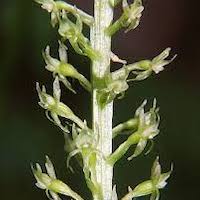






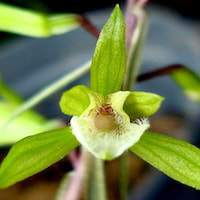


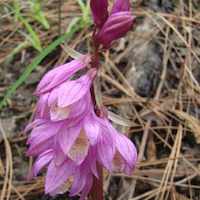





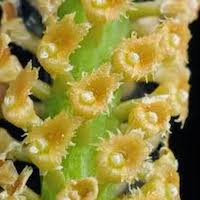
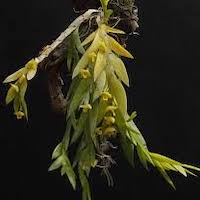

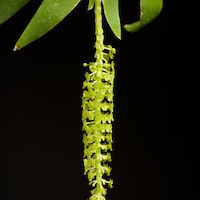




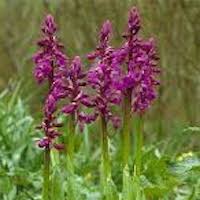
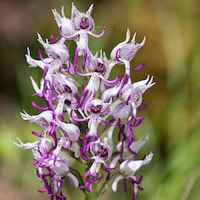

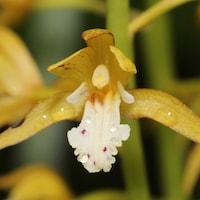
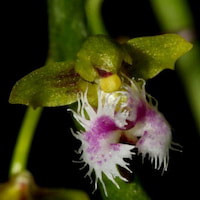
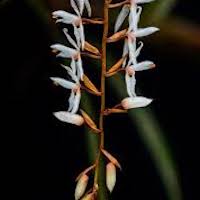
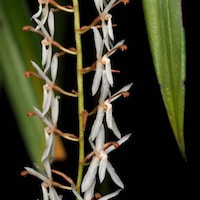

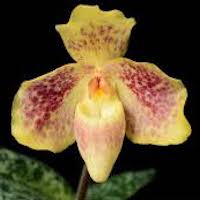
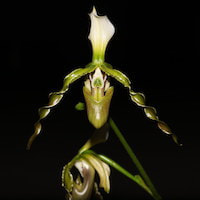

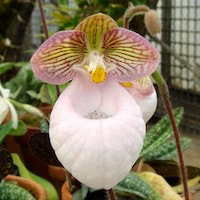

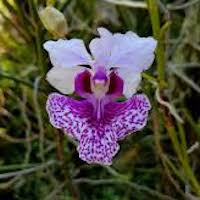







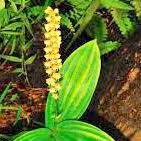


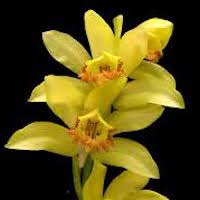

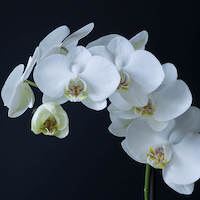
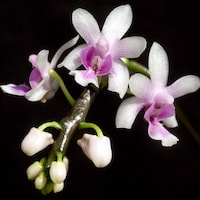
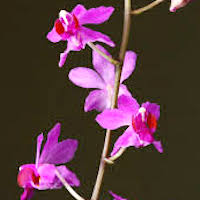
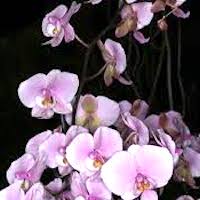




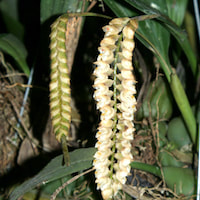
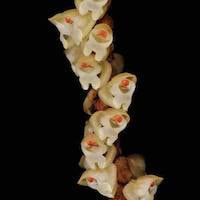
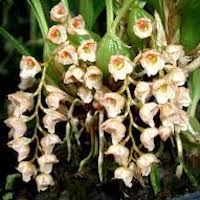

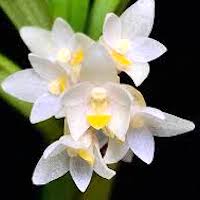




![Therapeutic and scented orchid of sentosa Platanthera fuscescens (L.) Kraenz.] syn. Platanthera souliei Kraenz., Tulotis asiatica Hara](/uploads/1/1/6/3/116352749/platanthera-fuscescens-l-kraenz-orig_orig.jpg)



